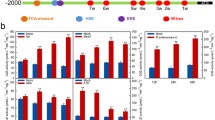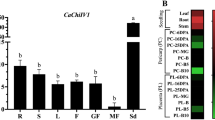Abstract
Main conclusion
Pepper CaMLO2 specifically interacts with CaCaM1 and translocates cytoplasmic CaCaM1 to the plasma membrane, leading to the suppression of Xanthomonas AvrBsT-triggered Ca 2+ influx, hypersensitive cell death and defense responses.
Abstract
Pathogen-induced cell death is closely linked with disease susceptibility and resistance in plants. Pepper (Capsicum annuum) mildew resistance locus O (CaMLO2) and calmodulin (CaCaM1) genes are required for disease-associated cell death and hypersensitive cell death, respectively. Here, we demonstrate that pathogen-responsive CaMLO2 interacts with CaCaM1 in yeast and in planta. Bimolecular fluorescence complementation and co-immunoprecipitation analyses confirm a specific interaction between CaMLO2 and CaCaM1 at the plasma membrane (PM) in plant cells. Subcellular localization analyses of CaCaM1 fused to green fluorescent protein reveals that treatment with Ca2+ and co-expression with CaMLO2 induce translocation of cytosolic CaCaM1 to the PM where CaMLO2 is localized. Transient CaMLO2 expression negatively regulates CaCaM1 accumulation in Nicotiana benthamiana. Xanthomonas avrBsT-triggered Ca2+ influx and hypersensitive cell death are disrupted by CaCaM1 and/or CaMLO2 expression. CaMLO2 silencing in pepper significantly enhances reactive oxygen species burst, cell death, and resistance responses to Xanthomonas campestris pv. vesicatoria Ds1 and Ds1 (avrBsT), which is accompanied by enhanced induction of CaCaM1, CaPR1 (PR-1), and CaPO2 (peroxidase). These results suggest that CaMLO2 interacts with CaCaM1 and suppresses AvrBsT-triggered cell death and defense responses.








Similar content being viewed by others
References
Blume B, Nürnberger T, Nass N, Scheel D (2000) Receptor-mediated increase in cytoplasmic free calcium required for activation of pathogen defense in parsley. Plant Cell 12:1425–1440
Bockaert J, Pin JP (1999) Molecular tinkering of G protein-coupled receptors: an evolutionary success. EMBO J 18:1723–1729
Boller T, He SY (2009) Innate immunity in plants: an arms race between pattern recognition receptors in plants and effectors in microbial pathogens. Science 324:742–744
Choi DS, Hwang BK (2011) Proteomics and functional analyses of pepper abscisic acid–responsive 1 (ABR1), which is involved in cell death and defense signaling. Plant Cell 23:823–842
Choi HW, Hwang BK (2012) The pepper extracellular peroxidase CaPO2 is required for salt, drought and oxidative stress tolerance as well as resistance to fungal pathogens. Planta 235:1369–1382
Choi HW, Kim YJ, Lee SC, Hong JK, Hwang BK (2007) Hydrogen peroxide generation by the pepper extracellular peroxidase CaPO2 activates local and systemic cell death and defense response to bacterial pathogens. Plant Physiol 145:890–904
Choi HW, Lee DH, Hwang BK (2009) The pepper calmodulin gene CaCaM1 is involved in reactive oxygen species and nitric oxide generation required for cell death and the defense response. Mol Plant Microbe Interact 22:1389–1400
Choi HW, Kim YJ, Hwang BK (2011) The hypersensitive induced reaction and leucine-rich repeat proteins regulate plant cell death associated with disease and plant immunity. Mol Plant Microbe Interact 24:68–78
Choi DS, Hwang IS, Hwang BK (2012) Requirement of the cytosolic interaction between pathogenesis-related protein10 and leucine-rich repeat protein1 for cell death and defense signaling in pepper. Plant Cell 24:1675–1690
Ciesiolka LD, Hwin T, Gearlds JD, Minsavage GV, Saenz R, Bravo M, Handley V, Conover SM, Zhang H, Caporgno J, Phengrasamy NB, Toms AO, Stall RE, Whalen MC (1999) Regulation of expression of avirulence gene avrRxv and identification of a family of host interaction factors by sequence analysis of avrBsT. Mol. Plant-Microbe Interact 12:35–44
Collins NC, Thordal-Christensen H, Lipka V, Bau S, Kombrink E, Qiu JL, Hückelhoven R, Stein M, Freialdenhoven A, Somerville SC, Schulze-Lefert P (2003) SNARE-protein-mediated disease resistance at the plant cell wall. Nature 425:973–977
Consonni C, Humphry ME, Hartmann HA, Livaja M, Durner J, Westphal L, Vogel J, Lipka V, Kemmerling B, Schulze-Lefert P, Somerville SC, Panstruga R (2006) Conserved requirement for a plant host cell protein in powdery mildew pathogenesis. Nat Genet 38:716–720
Devoto A, Piffanelli P, Nilsson I, Wallin E, Panstruga R, von Heijne G, Schulze-Lefert P (1999) Topology, subcellular localization, and sequence diversity of the Mlo family in plants. J Biol Chem 274:34993–35004
Do HM, Lee SC, Jung HW, Sohn KH, Hwang BK (2004) Differential expression and in situ localization of a pepper defensin (CADEF1) gene in response to pathogen infection, abiotic elicitors and environmen. Plant Sci 166:1297–1305
Grant M, Brown I, Adams S, Knight M, Ainslie A, Mansfield J (2000) The RPM1 plant disease resistance gene facilitates a rapid and sustained increase in cytosolic calcium that is necessary for the oxidative burst and hypersensitive cell death. Plant J 23:441–450
Harding SA, Oh SH, Roberts DM (1997) Transgenic tobacco expressing a foreign calmodulin gene shows an enhanced production of active oxygen species. EMBO J 16:1137–1144
He P, Shan L, Sheen J (2007) Elicitation and suppression of microbe-associated molecular pattern-triggered immunity in plant-microbe interactions. Cell Microbiol 9:1385–1396
Humphry M, Consonni C, Panstruga R (2006) mlo-based powdery mildew immunity: silver bullet or simply non-host resistance? Mol Plant Pathol 7:605–610
Hwang BK, Lee JT, Hwang BG, Koh YJ (1995) Restriction fragment length polymorphism analyses of the plasmid DNAs in strains of Xanthomonas campestris pv. vesicatoria from different geographic areas. J Phytopathol 143:185–191
Ito H, Fukuda Y, Murata K, Kimura A (1983) Transformation of intact yeast cells treated with alkali cations. J Bacteriol 153:163–168
Jones JD, Dangl JL (2006) The plant immune system. Nature 444:323–329
Jones JB, Stall RE, Bouzar H (1998) Diversity among Xanthomonads pathogenic on pepper and tomato. Annu Rev Phytopathol 36:41–58
Jones JB, Lacy GH, Bouzar H, Stall RE, Schaad NW (2004) Reclassification of the Xanthomonads associated with bacterial spot disease of tomato and pepper. Syst Appl Micobiol 27:755–762
Jung HW, Hwang BK (2000) Isolation, partial sequencing, and expression of pathogenesis-related cDNA genes from pepper leaves infected by Xanthomonas campestris pv. vesicatoria. Mol Plant Microbe Interact 13:136–142
Kim YJ, Hwang BK (2000) Pepper gene encoding a basic PR-1 protein is pathogen and ethylene inducible. Physiol Plant 108:51–60
Kim DS, Hwang BK (2012) The pepper MLO gene, CaMLO2, is required for susceptibility cell death response and bacterial and oomycete proliferation. Plant J 72:843–855
Kim MC, Lee SH, Kim JK, Chun HJ, Choi MS, Chung WS, Moon BC, Kang CH, Park CY, Yoo JH, Kang YH, Koo SC, Koo YD, Jung JC, Kim ST, Schulze-Lefert P, Lee SY, Cho MJ (2002a) Mlo, a modulator of plant defense and cell death, is a novel calmodulin-binding protein. Isolation and characterization of a rice Mlo homologue. J Biol Chem 277:19304–19314
Kim MC, Panstruga R, Elliott C, Müller J, Devoto A, Yoon HW, Park HC, Cho MJ, Schulze-Lefert P (2002b) Calmodulin interacts with MLO protein to regulate defence against mildew in barley. Nature 416:447–451
Kim NH, Choi HW, Hwang BK (2010) Xanthomonas campestris pv. vesicatoria effector AvrBsT induces cell death in pepper, but suppresses defense responses in tomato. Mol Plant Microbe Interact 23:1069–1082
Kim NH, Kim DS, Chung EH, Hwang BK (2014) Pepper suppressor of the G2 allele of skp1 interacts with the receptor-like cytoplasmic kinase 1 and type III effector AvrBsT and promotes the hypersensitive cell death response in a phosphorylation-dependent manner. Plant Physiol 165:76–91
Lee SC, Hwang BK (2005) Induction of some defense-related genes and oxidative burst is required for the establishment of systemic acquired resistance in Capsicum annuum. Planta 221:790–800
Lee YK, Kim YJ, Hwang BK (1994) Bacterial multiplications and electrophoretic patterns of soluble proteins in compatible and incompatible interactions of pepper leaves with Xanthomonas campestris pv. vesicatoria. Korean J Plant Pathol 10:305–313
Lim CW, Lee SC (2014) Functional roles of the pepper MLO protein gene, CaMLO2, in abscisic acid signaling and drought sensitivity. Plant Mol Biol 85:1–10
Lipka U, Fuchs R, Lipka V (2008) Arabidopsis non-host resistance to powdery mildews. Curr Opin Plant Biol 11:404–411
Lorek J, Griebel T, Jones AM, Kuhn H, Panstruga R (2013) The role of Arabidopsis heterotrimeric G-protein subunits in MLO2 function and MAMP-triggered immunity. Mol Plant Microbe Interact 26:991–1003
Lyngkjaer MF, Newton AC, Atzema JL, Baker SJ (2000) The Barley mlo-gene: an important powdery mildew resistance source. Agronomie 20:745–756
Ma W, Berkowitz GA (2007) The grateful dead: calcium and cell death in plant innate immunity. Cell Microbiol 9:2571–2585
Ma W, Smigel A, Tsai YC, Braam J, Berkowitz GA (2008) Innate immunity signaling: cytosolic Ca2+ elevation is linked to downstream nitric oxide generation through the activation of calmodulin or a calmodulin-like protein. Plant Physiol 148:818–828
Miedaner T, Korzun V (2012) Marker-assisted selection for disease resistance in wheat and barley breeding. Phytopathol 102:560–566
Minsavage GV, Dahlbeck D, Whalen MC, Kearney B, Bonas U, Staskawicz BJ, Stall RE (1990) Gene-for-gene relationships specifying disease resistance in Xanthomonas campestris pv. vesicatoria-pepper interactions. Mol Plant-Microbe Interact 3:41–47
Monaghan J, Zipfel C (2012) Plant pattern recognition receptor complexes at the plasma membrane. Curr Opin Plant Biol 15:349–357
Mysore KS, Ryu CM (2004) Nonhost resistance: how much do we know? Trends Plant Sci 9:97–104
Nürnberger T, Lipka V (2005) Non-host resistance in plants: new insights into an old phenomenon. Mol Plant Pathol 6:335–345
Pike SM, Zhang XC, Gassmann W (2005) Electrophysiological characterization of the Arabidopsis avrRpt2-specific hypersensitive response in the absence of other bacterial signals. Plant Physiol 138:1009–1017
Price AH, Taylor A, Ripley SJ, Griffiths A, Trewavas AJ, Knight MR (1994) Oxidative signals in tobacco increase cytosolic calcium. Plant Cell 6:1301–1310
Stein M, Somerville SC (2002) MLO, a novel modulator of plant defenses and cell death, binds calmodulin. Trends Plant Sci 7:379–380
Thordal-Christensen H (2003) Fresh insights into processes of nonhost resistance. Curr Opin Plant Biol 6:351–357
Walter M, Chaban C, Schütze K, Batistic O, Weckermann K, Näke C, Blazevic D, Grefen C, Schumacher K, Oecking C, Harter K, Kudla J (2004) Visualization of protein interactions in living plant cells using bimolecular fluorescence complementation. Plant J 40:428–438
Xu H, Heath MC (1998) Role of calcium in signal transduction during the hypersensitive response caused by basidiospore-derived infection of the cowpea rust fungus. Plant Cell 10:585–598
Zheng Z, Nonomura T, Appiano M, Pavan S, Matsuda Y, Toyoda H, Wolters AM, Visser RG, Bai Y (2013) Loss of function in Mlo orthologs reduces susceptibility of pepper and tomato to powdery mildew disease caused by Leveillula taurica. PLoS One 8:e70723
Acknowledgments
This work was carried out with support from the Cooperative Research Program for Agriculture Science & Technology (Project No. PJ00802701), Rural Development Administration, Republic of Korea.
Author information
Authors and Affiliations
Corresponding author
Electronic supplementary material
Below is the link to the electronic supplementary material.
Rights and permissions
About this article
Cite this article
Kim, D.S., Choi, H.W. & Hwang, B.K. Pepper mildew resistance locus O interacts with pepper calmodulin and suppresses Xanthomonas AvrBsT-triggered cell death and defense responses. Planta 240, 827–839 (2014). https://doi.org/10.1007/s00425-014-2134-y
Received:
Accepted:
Published:
Issue Date:
DOI: https://doi.org/10.1007/s00425-014-2134-y




